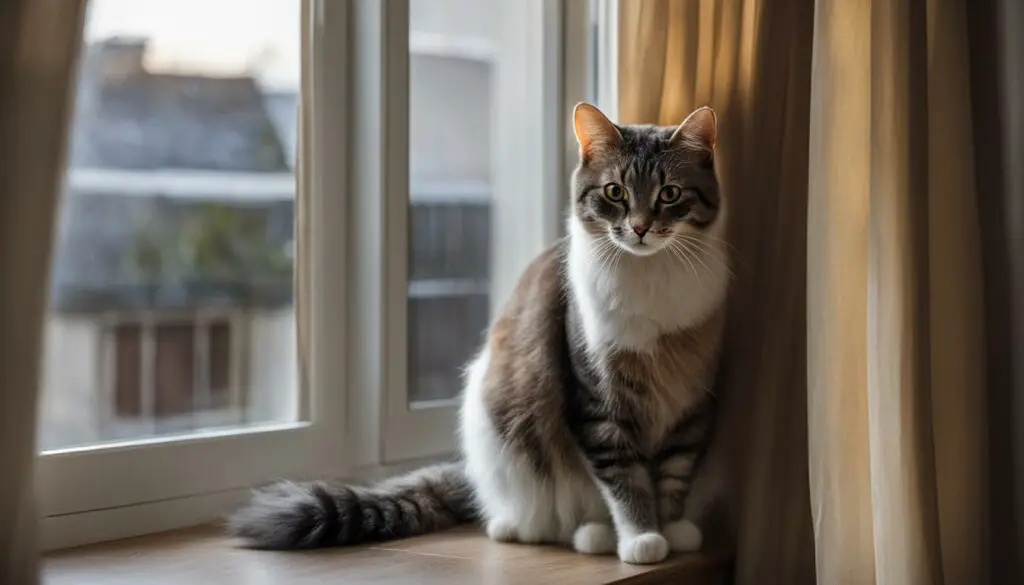It can be disheartening when our beloved feline friends exhibit behaviors that make us question if they truly hate us. But fear not, understanding cat behavior is the key to unraveling this mystery. Cats, with their unique personalities and instincts, often communicate in ways that may seem puzzling to us humans. In this article, we will delve into the reasons why cats may appear to hate their owners and explore how we can strengthen the cat-human bond.
Key Takeaways:
- Understanding cat behavior is essential in building a strong bond with your feline companion.
- Cats have different personalities and preferences, which influence their interactions with humans.
- Behaviors that may seem like hatred are often rooted in a cat’s natural instincts and past experiences.
- Creating a positive environment, respecting their personal space, and offering mental and physical stimulation can help foster a deeper connection.
- Seeking professional help from a cat behaviorist or veterinarian may be beneficial in addressing challenging behaviors.
The History of Cats and Dogs
When it comes to understanding cat behavior, it’s important to consider the different histories of domestication between cats and dogs. While dogs were domesticated earlier and evolved to become more attached and emotionally connected to humans, cats have a more independent nature. Cats actually domesticated themselves by living among humans in search of food, particularly rodents. This unique history explains why cats may not exhibit the same level of emotional attachment as dogs do.
Understanding the history of cat and dog domestication helps put their behavior into context. Cats have retained their independent instincts, making them more inclined to be self-reliant and less likely to seek constant attention and emotional connection. While cats may not show their affection in the same way as dogs, they can still form deep and meaningful bonds with their human companions.
“Cats have retained their independent instincts, making them more inclined to be self-reliant and less likely to seek constant attention and emotional connection.”
In contrast, dogs were purposefully bred over centuries to be companions to humans, resulting in a stronger desire and ability to form deep emotional bonds. This difference in domestication history plays a significant role in shaping the behavior and interactions between cats and dogs, as well as their relationships with humans.
| Cat Domestication | Dog Domestication |
|---|---|
| Cats domesticated themselves, living among humans to hunt rodents | Dogs were purposefully bred to be companions to humans |
| Cats have a more independent nature and tend to be self-reliant | Dogs have a stronger desire to form emotional bonds with humans |
| Cats may not exhibit the same level of emotional attachment as dogs | Dogs are more likely to seek constant attention and emotional connection |

The history of domestication highlights the importance of understanding and respecting the unique nature of cats. While they may not exhibit the same level of emotional attachment as dogs, cats can still form strong bonds with their owners. By recognizing and appreciating these differences, we can create a harmonious and fulfilling relationship with our feline friends.
Understanding Cat Behavior
Cats have unique personalities and moods, just like humans. Some cats are loners and prefer to spend most of their time alone, while others are more social and seek constant attention. Understanding these individual characteristics can help decipher cat behavior and strengthen the bond between cats and their owners.
Personality Traits and Temperament
When it comes to cat behavior, personality traits play a significant role. Some cats are naturally more laid-back and easygoing, while others may be more high-strung or skittish. Factors such as genetics, early socialization, and past experiences can shape a cat’s personality. Recognizing and respecting these individual traits can help set realistic expectations and create a harmonious environment for both the cat and the owner.
It is important to note that a cat’s personality may also influence their response to various stimuli. For example, an outgoing and confident cat may be more tolerant of changes in their routine, while a shy or anxious cat may become stressed or agitated in similar situations. Providing a safe and predictable environment can help cats feel more secure and reduce unwanted behaviors.
Moods and Communication
Cats, like humans, experience different moods. They can go from playful and energetic to calm and relaxed within moments. Understanding and interpreting these moods is essential for effective communication with cats.
| Mood | Behavior |
|---|---|
| Relaxed | Resting, purring, kneading, slow blinking |
| Playful | Pouncing, chasing, batting at toys |
| Curious | Exploring, sniffing, investigating new objects |
| Anxious | Hiding, excessive grooming, avoiding interaction |
| Stressed | Excessive meowing, aggression, litter box issues |
Interpreting a cat’s body language and vocalizations can provide valuable insights into their current mood. For example, a cat with relaxed ears, a softly swaying tail, and a content purr is likely in a calm and happy state. On the other hand, a cat with flattened ears, dilated pupils, and an arched back may be feeling defensive or threatened. Paying attention to these subtle cues can help avoid unnecessary misunderstandings and foster better communication.
In conclusion, understanding cat behavior is a vital aspect of building a strong bond with our feline companions. Recognizing their unique personalities, respecting their preferences, and interpreting their moods and communication signals enables us to provide them with the care and environment they need to thrive. By nurturing this understanding and adapting our interactions accordingly, we can create a harmonious relationship filled with love, trust, and mutual respect.
Could Your Cat Be Feeling Unwell?
If you notice sudden changes in your cat’s behavior, such as increased irritability or excessive hiding, it could be a sign that they are feeling unwell. Cats are experts at masking pain or discomfort, so it’s important to pay attention to any significant behavior changes. Consulting a veterinarian is crucial in order to rule out any underlying health issues that may be causing your cat’s unusual behavior.
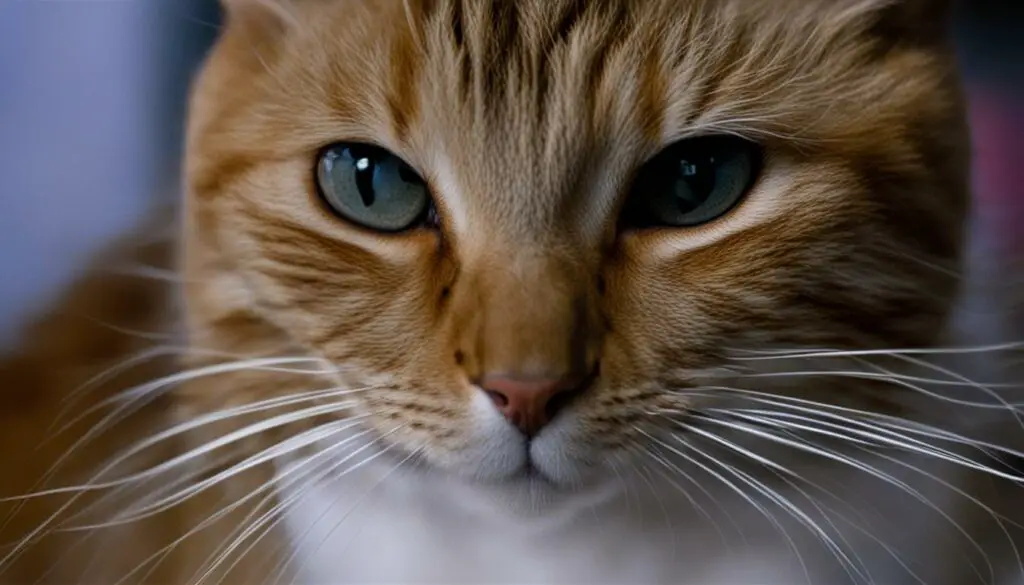
Common signs of illness in cats include changes in appetite, excessive grooming or lack thereof, lethargy, vomiting, diarrhea, and changes in litter box habits. If your cat is displaying any of these symptoms along with behavioral changes, it’s best to seek professional veterinary care.
Remember, cats cannot communicate their feelings and discomfort in the same way humans do, so it’s important to be proactive in monitoring their health and seeking veterinary attention when needed. By addressing any potential health issues, you can help your cat feel better and improve their overall well-being.
The Impact of Routine Changes
Adjusting to change can be challenging for cats, as they thrive on routine and familiarity. Any disruption to their established routines can cause stress and anxiety, which may lead to changes in their behavior. It is important for cat owners to understand the impact of routine changes and take steps to help their cats adjust.
When introducing a new pet or roommate, it is crucial to do so gradually and provide a safe, separate space for the cat to retreat to if needed. This allows the cat to slowly adapt to the new presence in their environment. Additionally, maintaining a consistent feeding and playtime schedule can provide a sense of stability and predictability for the cat.
By offering reassurance and providing a calm environment, cat owners can help their feline companions navigate routine changes more smoothly. Patience is key during this process, as it may take time for cats to fully adjust and feel comfortable. Consistency, understanding, and a gentle approach can go a long way in helping cats cope with routine changes and maintain their overall well-being.
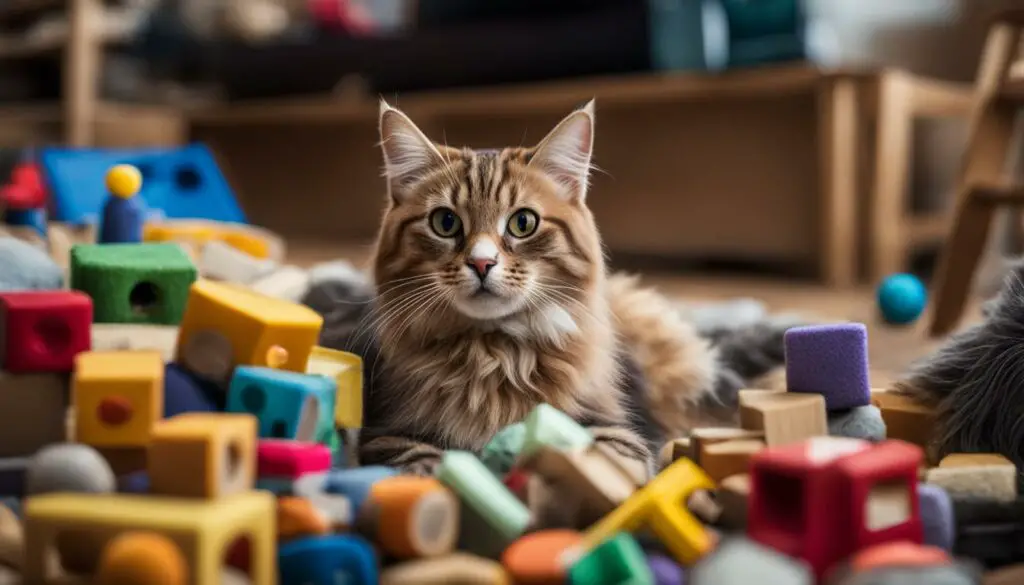
Table: Tips for Helping Cats Adjust to Routine Changes
| Tip | Description |
|---|---|
| Gradual Introductions | Introduce new pets or roommates slowly and provide separate spaces for the cat to retreat to |
| Consistent Schedule | Maintain a consistent feeding and playtime schedule to provide a sense of stability |
| Reassurance | Offer reassurance and create a calm environment to help your cat feel secure |
| Patience | Be patient and understanding as cats may take time to adjust to changes |
Kittens and Playful Behavior
Kittens are known for their playful behavior, and it’s important to understand and encourage these natural instincts. Playtime not only provides them with physical exercise but also helps them learn essential skills and build social bonds. As kittens explore their environment, they may engage in behaviors such as biting, scratching, or nipping, which can sometimes be mistaken for aggression.
By providing appropriate toys and activities, you can redirect their playful behavior and prevent them from associating play with negative interactions. Interactive toys, such as wand toys or puzzle feeders, can stimulate their minds and offer a positive outlet for their energy. It’s crucial to establish boundaries by redirecting any biting or scratching onto appropriate toys and teaching them what is acceptable play behavior.
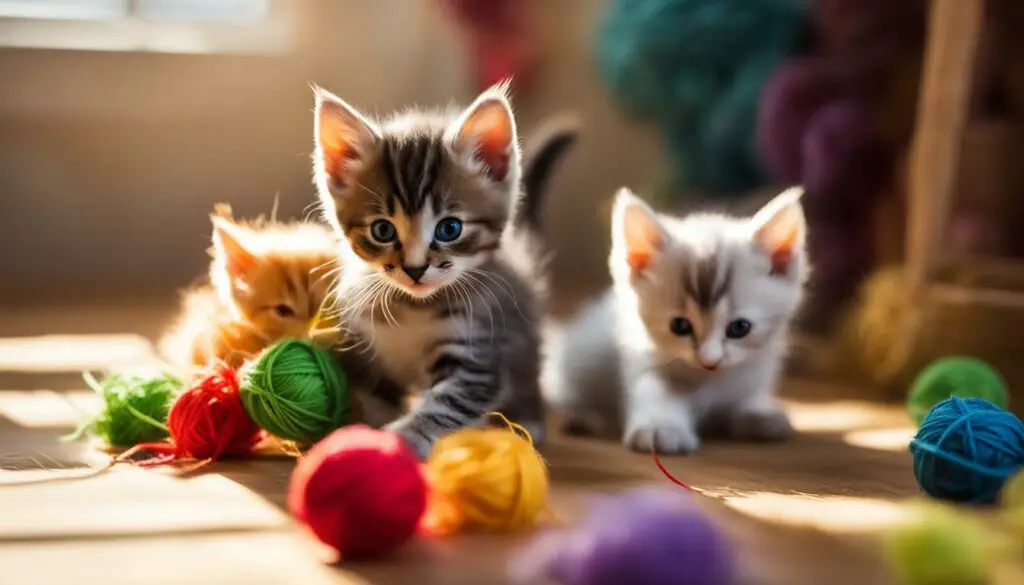
Why Does My Cat Love Me Then Attack Me?
It is not uncommon for cats to exhibit behaviors where they seem affectionate one moment and then suddenly become aggressive. This behavior is often a result of play aggression, where the cat is trying to engage their owner in play. Encouraging play with appropriate toys and redirecting any biting or scratching behavior can help establish boundaries and prevent negative interactions.
“Play aggression is a common behavior in cats, especially when they are young and full of energy,” says Dr. Sarah Thompson, a feline behavior specialist. Cats use their teeth and claws to play, and sometimes it can be a bit rough for humans. Providing interactive toys and engaging in structured play sessions can help redirect their natural hunting instincts and prevent them from using their teeth and claws on you.”
It’s important to set clear boundaries with your cat when it comes to play. If your cat becomes too rough during play, calmly withdraw your attention and redirect them to appropriate toys. Avoid engaging in rough play with your hands or feet, as this can encourage more aggressive behavior. Teaching your cat the difference between appropriate play and inappropriate biting or scratching is crucial for a harmonious relationship.
Remember, cats are not trying to intentionally harm or attack you. By understanding their needs for play and providing them with appropriate outlets, you can foster a positive and loving bond with your feline friend.
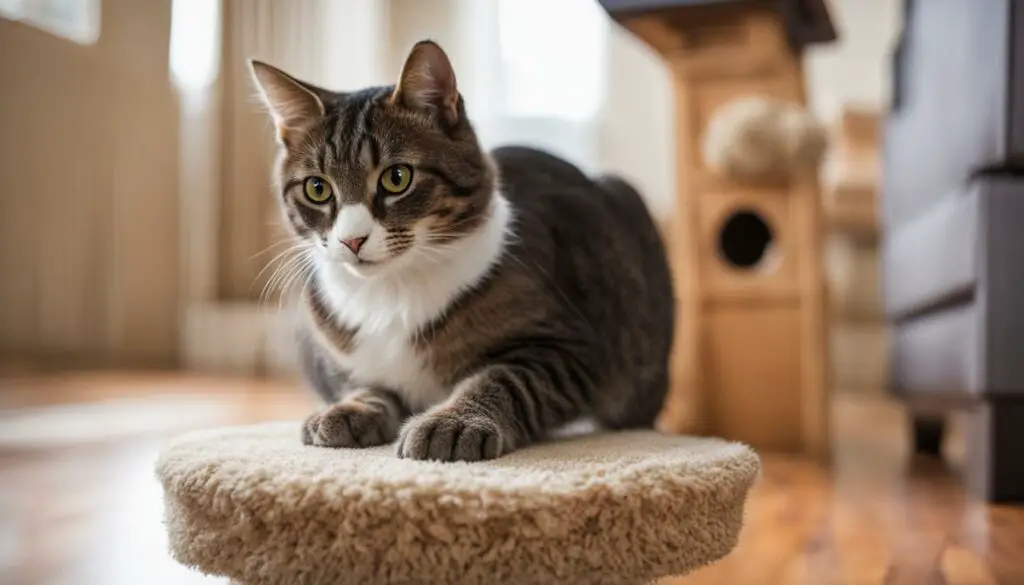
Can Cats Dislike Their Owners?
While cats are generally known for their independent nature, it is rare for them to truly dislike their owners. Most of the time, a cat’s behavior that may seem like dislike is actually rooted in their unique preferences and instincts. Cats have individual personalities and may not bond with every person in their household in the same way. It’s important to remember that cats have their own likes and dislikes, just like humans do.
Understanding a cat’s preferences and giving them space when needed can go a long way in building a positive cat-human relationship. Some cats may prefer a more hands-off approach, while others may enjoy constant attention. Respecting their personal boundaries and allowing them to come to you when they feel comfortable can help strengthen the bond between you and your feline friend.
It’s also important to note that cats have their own unique ways of showing affection. While they may not display it in the same overt way as dogs, cats often show their love through subtle gestures such as slow blinking, kneading, or rubbing against their owners. Taking the time to understand and appreciate these gestures can deepen your connection with your cat and help foster a strong and loving relationship.
In summary, while it is possible for a cat to not prefer the company of a specific person, true dislike is rare. Cats have their own individual personalities and preferences, and it’s important to respect and understand these traits. By giving your cat space, recognizing their unique ways of showing affection, and respecting their boundaries, you can build a stronger and more harmonious cat-human bond.
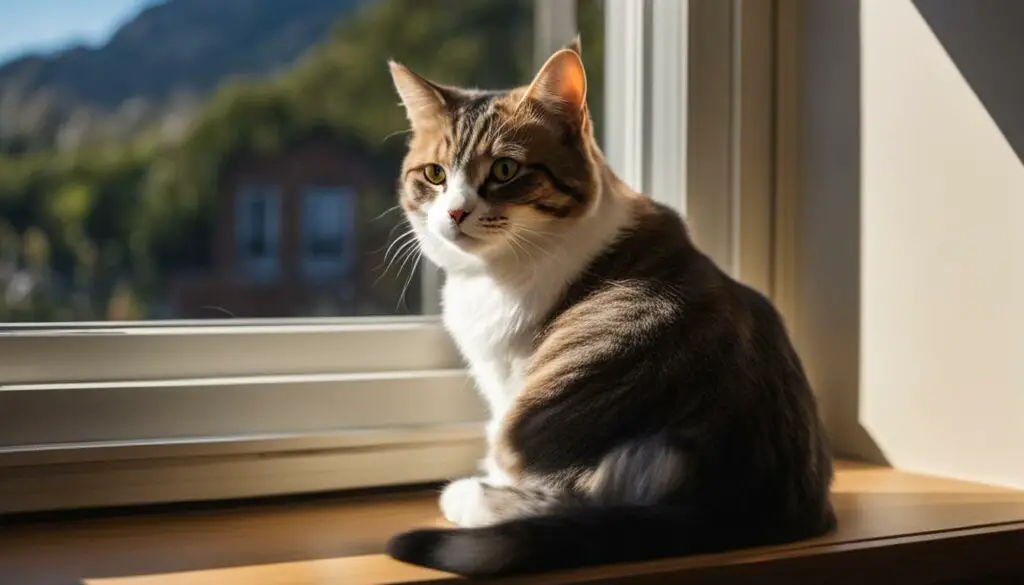
Tips for Building a Stronger Cat-Human Bond
Building a strong bond with your cat is essential for a harmonious and fulfilling relationship. Here are some tips to help you strengthen the cat-human bond:
- Respect their personal space: Cats value their alone time, so make sure to provide them with a quiet and comfortable space where they can retreat when they need some solitude.
- Engage in interactive play sessions: Cats need mental and physical stimulation. Set aside regular playtime to engage with your cat using toys and interactive games. This not only provides exercise but also helps build a positive association with you.
- Practice positive reinforcement: Use treats, praise, and rewards to encourage good behavior. Positive reinforcement techniques help build trust and create a positive environment for your cat.
- Establish a consistent routine: Cats thrive on routine, so try to maintain a consistent schedule for feeding, playtime, and other activities. Sudden changes can cause stress and disrupt the bond you’ve built with your cat.
- Offer treats and rewards: Giving your cat treats and rewards can help create positive associations and strengthen the bond between you. Use treats as a way to reward good behavior or as a means of bonding during training sessions.
By implementing these strategies, you can foster a deeper connection and understanding with your cat, building a stronger bond that will enhance your relationship and bring you both joy and companionship.
Remember, building a strong cat-human bond takes time and patience. Each cat is unique and may require different approaches to bond effectively. Be attentive to your cat’s needs and preferences, and always prioritize their well-being and comfort. With love, care, and understanding, you can create a lasting and fulfilling bond with your feline companion.
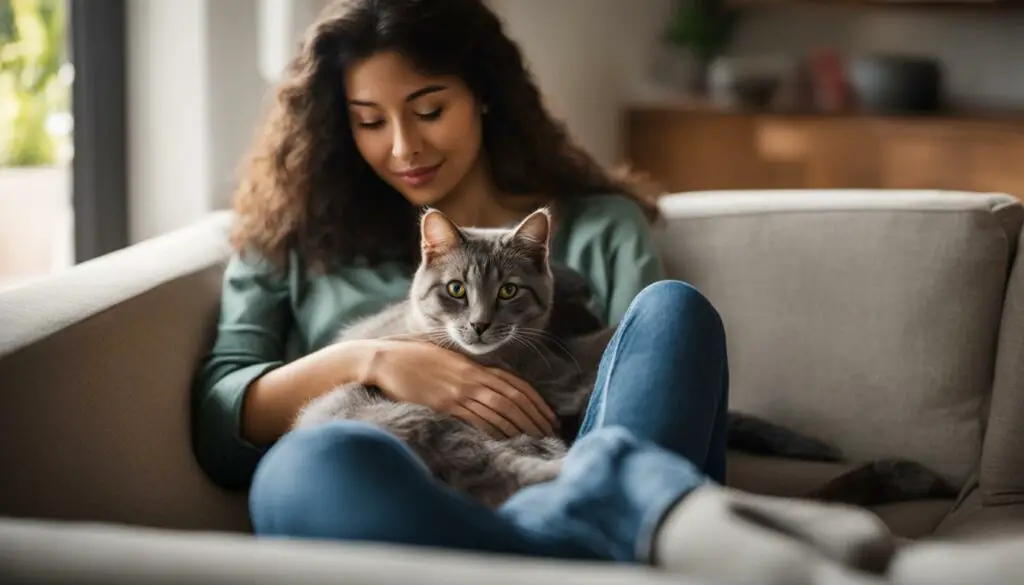
References:
- Johnson, C. A. (2020). The Cat Whisperer: Why Cats Do What They Do – and How to Get Them to Do What You Want. Penguin.
- Bradshaw, J. W., & Ellis, S. L. (2019). Cat Sense: The Feline Enigma Revealed. Basic Books.
- Nicholas, F. W., & Björkman, S. (2018). The Welfare of Cats. Springer International Publishing.
Creating a Positive Environment for Your Cat
Cats thrive in a positive environment that caters to their specific needs and desires. By providing them with a comfortable and safe living space, you can promote their overall well-being and happiness. Here are some key aspects to consider when creating an ideal environment for your feline companion:
1. A Cozy and Secure Living Space
Ensure that your cat has a dedicated space where they can retreat to when they need time alone. This can be a separate room or a cozy corner equipped with their bed, litter box, and toys. The space should be quiet, free from disturbances, and easily accessible to your cat. Additionally, make sure that windows and doors are securely closed to prevent any potential escapes or accidents.
2. Enrichment and Stimulation
Cats are natural hunters and love to engage in playful activities. Provide a variety of toys that encourage them to chase, pounce, and explore. Interactive toys that mimic prey can be particularly engaging for cats. Consider incorporating scratching posts, climbing trees, and puzzle toys to satisfy their natural instincts. Regular play sessions and environmental enrichment help keep cats mentally stimulated and prevent boredom and destructive behaviors.
3. Vertical Spaces and Hideouts
Cats also enjoy vertical spaces, as they provide them with a sense of security and allow them to observe their surroundings from a higher vantage point. Install shelves, perches, or cat trees that give your cat opportunities to climb and explore. Additionally, provide hiding spots such as cozy boxes or covered beds where your cat can retreat when they feel the need for privacy or relaxation.
Creating a positive environment for your cat promotes their well-being and helps establish a strong bond between you and your feline friend. By providing them with a cozy and secure living space, enrichment and stimulation, as well as vertical spaces and hideouts, you are creating an environment that caters to their natural instincts and preferences. Remember, a happy and contented cat is more likely to thrive and have a deeper connection with their human companion.
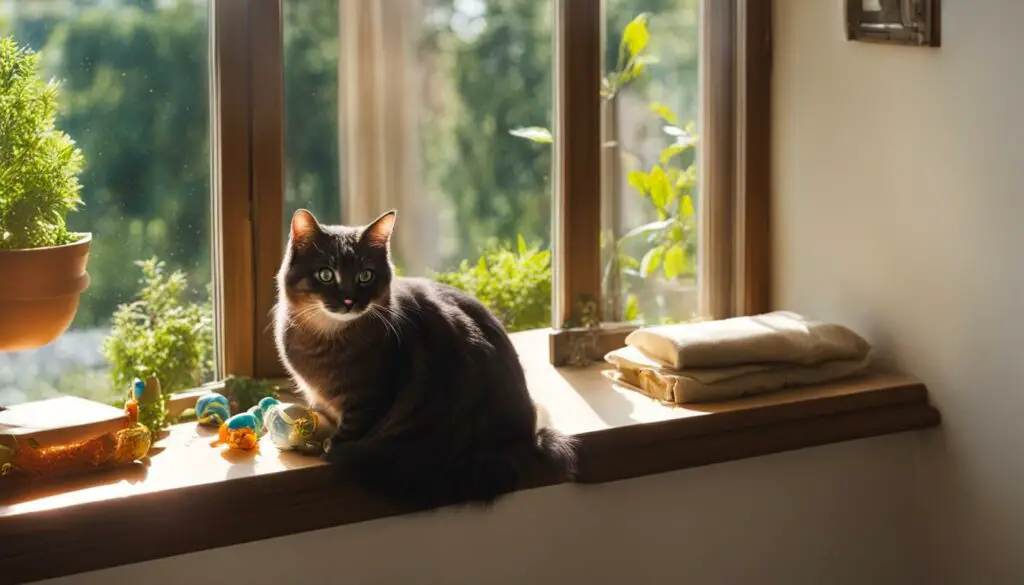
| Benefits of a Positive Cat Environment | Ways to Create a Positive Environment |
|---|---|
| 1. Reduces stress and anxiety | 1. Provide a cozy and secure living space |
| 2. Promotes physical and mental stimulation | 2. Enrichment and stimulation through toys and activities |
| 3. Prevents destructive behaviors | 3. Incorporate vertical spaces and hideouts |
| 4. Enhances overall well-being and happiness | 4. Regular play sessions and interaction |
Seeking Professional Help
If you are facing difficulties in understanding or addressing your cat’s behavior, seeking professional help from a cat behaviorist or veterinarian specializing in feline behavior can be a valuable option. These experts have the knowledge and experience to assess your cat’s specific needs and provide personalized guidance.
A cat behaviorist is a professional who specializes in understanding and modifying feline behavior. They can help identify the underlying causes of your cat’s behavior problems and develop a customized behavior modification plan. A behaviorist will work closely with you to address issues such as aggression, litter box problems, excessive scratching, or anxiety.
Veterinarians specializing in feline behavior are another valuable resource. They can conduct a thorough medical evaluation to rule out any underlying health issues that may be contributing to your cat’s behavior problems. They can also provide recommendations for behavior management techniques and medications, if necessary.
Remember, seeking professional help is a proactive step towards improving your cat’s well-being and strengthening your bond. These experts can offer invaluable insights and strategies that can make a significant difference in resolving behavior problems and promoting a harmonious relationship with your cat.

Testimonial: The Importance of Professional Guidance
“After struggling to understand my cat’s aggressive behavior and unsuccessful attempts at resolving it, I decided to seek help from a cat behaviorist. The behaviorist conducted a comprehensive assessment of my cat’s behavior and provided me with a tailored behavior modification plan. With their expert guidance, I was able to address the underlying causes of my cat’s aggression and foster a more harmonious relationship. I highly recommend seeking professional help when facing challenging behavior issues with your cat.”
Benefits of Seeking Professional Help
- Expert knowledge and experience in feline behavior
- Personalized assessment and guidance for your cat’s specific needs
- Identification of underlying causes contributing to behavior problems
- Customized behavior modification plans
- Medical evaluation to rule out health issues
- Recommendations for behavior management techniques and medications
| Seeking Professional Help | Benefits |
|---|---|
| Consulting a cat behaviorist | Expert understanding and modification of feline behavior |
| Specialized veterinarian | Thorough medical evaluation and behavior management recommendations |
The Importance of Love and Patience
Building a strong bond with your cat requires love and patience. Cats have unique personalities and may not express their affection in the same way as dogs or humans. But that doesn’t mean they don’t love their owners. It’s important to recognize and value their individual ways of showing love.
Cats communicate their love through subtle gestures, such as rubbing against your leg, purring, or giving slow blinks. These actions indicate trust and affection. By paying attention to these signals and responding in kind, you can strengthen the cat-human relationship.
Additionally, patience is crucial when it comes to understanding your cat’s needs and behaviors. Cats are sensitive animals and may require time to adjust to changes in their environment or routine. It’s important to give them the space and time they need to feel comfortable and secure.
Patiently Observing Your Cat’s Body Language
Observing your cat’s body language can provide valuable insights into their emotions. For example, a cat with an arched back, flattened ears, and a swishing tail may be feeling frightened or agitated. On the other hand, a cat with relaxed body posture, slow blinking, and a purring sound is likely content and at ease.
Being patient and understanding allows you to respond appropriately to your cat’s needs. If your cat seems anxious or stressed, create a calm and safe environment for them. Provide hiding spots, comfortable resting areas, and interactive toys to help them relax and alleviate anxiety. Remember, a patient and loving approach will go a long way in nurturing a strong and harmonious bond with your feline companion.
| Benefits of Love and Patience in Building a Cat-Human Bond |
|---|
| 1. Enhances trust and mutual understanding. |
| 2. Creates a sense of security and comfort for your cat. |
| 3. Reduces stress and anxiety in both the cat and the owner. |
| 4. Fosters a positive and nurturing environment for your cat. |
| 5. Strengthens the emotional connection between you and your cat. |
By approaching your relationship with love and patience, you can create a deep and meaningful connection with your cat, allowing both of you to experience the joys of a strong cat-human bond.

The Benefits of a Strong Cat-Human Bond
Building a strong bond with your cat can have numerous benefits for both you and your furry companion. The cat-human bond goes beyond just having a pet and can provide emotional support, companionship, and even act as a form of therapy. Developing a deep connection with your cat can contribute to improved mental health and overall well-being.
Studies have shown that interacting with animals, including cats, can have a positive impact on reducing stress and anxiety. Cats provide comfort and unconditional love, creating a sense of calm and relaxation. They can be excellent emotional support animals, offering a soothing presence during difficult times or when dealing with emotional challenges.
“The love and companionship we receive from our cats can greatly enhance our sense of happiness and fulfill our need for connection.”
In addition to emotional support, a strong cat-human bond can also provide companionship. Cats are known for their independent nature, but they still enjoy spending quality time with their owners. Whether it’s cuddling on the couch, playing interactive games, or simply being in the same room, the bond between you and your cat can bring joy and fulfillment to both of your lives.
Furthermore, cats can act as therapy animals, contributing to various forms of therapy such as physical therapy, mental health therapy, and even addiction recovery. Their presence can help reduce stress, improve social skills, and enhance communication. Cats have a calming effect on individuals and can create a nurturing and non-judgmental environment, making them ideal therapy partners.
Overall, nurturing a strong cat-human bond can be mutually beneficial and enriching. It creates a sense of love, companionship, and emotional well-being for both you and your cat. By understanding and appreciating the unique connection you share, you can create a harmonious and fulfilling relationship that enhances your lives.
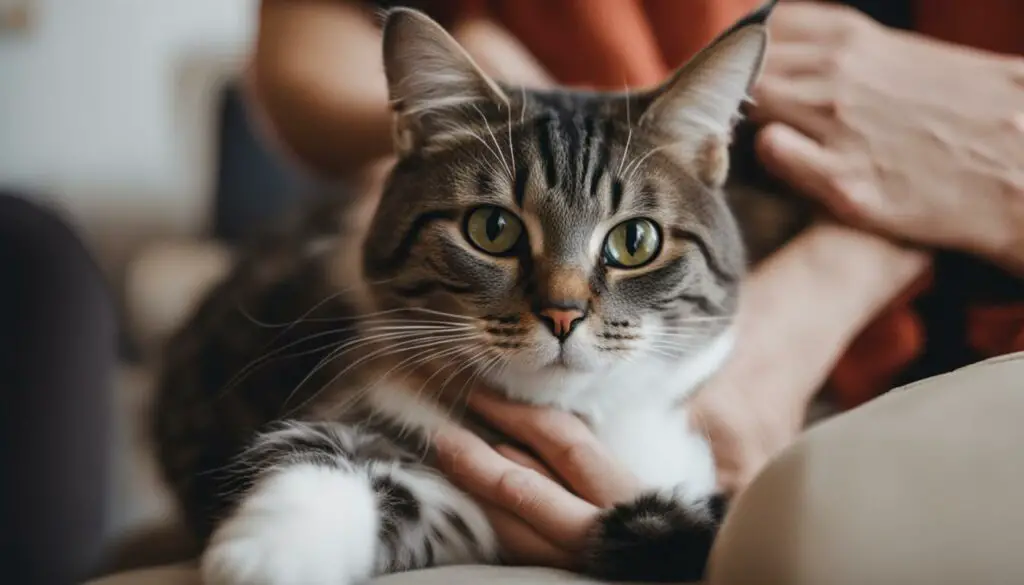
Table: Comparing the Benefits of Different Therapy Animals
| Animal | Benefits |
|---|---|
| Cats | Provide emotional support, companionship, and act as therapy animals for various forms of therapy. |
| Dogs | Offer emotional support, assist in physical therapy, and provide companionship. |
| Horses | Used in equine-assisted therapy to promote physical, emotional, and cognitive growth. |
| Rabbits | Offer comfort, reduce stress, and provide a calming presence. |
- Emotional support: Cats provide emotional support and can act as therapy animals, offering comfort and reducing stress.
- Companionship: Cats enjoy spending quality time with their owners, providing companionship and a sense of fulfillment.
- Therapy benefits: Cats contribute to various forms of therapy, such as physical therapy and mental health therapy.
- Non-judgmental environment: Cats create a nurturing and non-judgmental environment, ideal for therapy sessions.
Conclusion
Understanding cat behavior and fostering a strong cat-human bond is essential for a harmonious relationship. Cats may exhibit behaviors that seem like they hate their owners, but it’s important to remember that their actions are often rooted in their natural instincts and unique personalities. By taking the time to learn about feline emotions and behavior, we can deepen our understanding of our furry companions.
Building trust and respect is key to nurturing a strong bond with cats. Providing them with a comfortable and enriching environment, engaging in interactive play, and establishing a consistent routine can help them feel secure and loved. It’s crucial to respect their personal space and allow them to express themselves in their own unique way.
Remember, cats may not show affection in the same way as dogs or humans, but they have their own ways of expressing love. By being patient, observant, and attentive to their needs, we can create a lasting bond that brings joy and fulfillment to both the cat and the owner. So let’s embrace the unique quirks and behaviors of our feline friends and cherish the special connection we share with them.
FAQ
Why does my cat sometimes act like it hates me?
Cats have different personalities and behaviors, and their actions may not always reflect their true feelings. It’s important to understand that a cat’s behavior is often influenced by their natural instincts and past experiences.
Can cats form emotional connections with their owners?
Yes, cats can form deep emotional bonds with their owners. Although they may not express affection in the same way as dogs or humans, cats can still show love and establish strong connections with their owners in their own unique ways.
What should I do if my cat’s behavior suddenly changes?
Sudden changes in a cat’s behavior could be a sign of illness or injury. It’s important to consult a veterinarian to rule out any underlying health issues and ensure your cat’s well-being.
How can I strengthen my bond with my cat?
Building a strong cat-human bond requires time, patience, and understanding. Some tips include respecting their personal space, engaging in interactive play sessions, practicing positive reinforcement training, establishing a consistent routine, and offering treats and rewards.
Should I seek professional help for my cat’s behavior?
If you are experiencing significant difficulties in understanding or addressing your cat’s behavior, it may be helpful to seek professional help from a cat behaviorist or veterinarian specializing in feline behavior. They can provide personalized advice based on your cat’s specific needs.
How can I create a positive environment for my cat?
Creating a positive environment for your cat includes providing a comfortable and safe living space, access to scratching posts and toys, opportunities for mental and physical stimulation, and offering high-quality nutrition and regular veterinary care.
Can cats dislike certain people?
Yes, cats can form preferences and may not always bond with every individual in their household. It’s important to respect a cat’s personal preferences and give them space when needed.
What are the benefits of a strong cat-human bond?
A strong cat-human bond can provide emotional support, companionship, and contribute to improved mental health. Cats can also be excellent therapy animals and offer comfort during challenging times.

